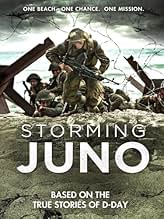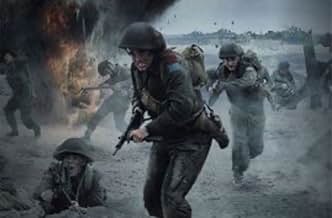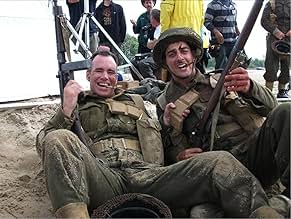Docudrama retelling the Canadian assault of Juno Beach on D-Day, as told via reenactment and through interviews with those who were there.Docudrama retelling the Canadian assault of Juno Beach on D-Day, as told via reenactment and through interviews with those who were there.Docudrama retelling the Canadian assault of Juno Beach on D-Day, as told via reenactment and through interviews with those who were there.
- Awards
- 1 win & 3 nominations total
Kevin Walker
- Hartigan
- (as Kevin Jake Walker)
Lester Brown
- Self
- (archive footage)
James Patrick Pettitt
- LCA Captain
- (as James Pettitt)
- Director
- Writer
- All cast & crew
- Production, box office & more at IMDbPro
Featured reviews
Everybody knows about Omaha Beach on D Day, the Sixth of June, 1944, because that was where the landings were truly blunted. But we don't hear much about the landings by the Canadians are Juno Beach, just down the road.
This lacks the lavish budget and dramatic screenplay of "Saving Private Ryan" but generally does a convincing job of showing true -- not fictional -- events on and behind the flat sands of Juno, though the film was shot on the shores of Lake Ontario.
Instead of staged combat, newsreel footage of the historical events is inserted -- effectively. And the incidents shown have the virtue of being reenactments of real events.
It's not a long film and it lacks the perspective of "The Longest Day." And it's usually confusing to hear narration by two participants -- a tank commander and a paratrooper -- using voices so similar that it's hard to distinguish them. "I did this," says one voice, and we see a tank commander shouting orders. And without notice, we hear what appears to be the same voice saying something similar and we're way behind the lines with a tiny group of infantrymen.
An earlier attempt was made to show some of the sacrifices of Canadians in "Dieppe" -- the story of a disaster -- but again was hobbled by a low budget, so that much of the story was confined to military leaders arguing over the planning.
It's not a bad film. It resembles a TV documentary using reenactors.
This lacks the lavish budget and dramatic screenplay of "Saving Private Ryan" but generally does a convincing job of showing true -- not fictional -- events on and behind the flat sands of Juno, though the film was shot on the shores of Lake Ontario.
Instead of staged combat, newsreel footage of the historical events is inserted -- effectively. And the incidents shown have the virtue of being reenactments of real events.
It's not a long film and it lacks the perspective of "The Longest Day." And it's usually confusing to hear narration by two participants -- a tank commander and a paratrooper -- using voices so similar that it's hard to distinguish them. "I did this," says one voice, and we see a tank commander shouting orders. And without notice, we hear what appears to be the same voice saying something similar and we're way behind the lines with a tiny group of infantrymen.
An earlier attempt was made to show some of the sacrifices of Canadians in "Dieppe" -- the story of a disaster -- but again was hobbled by a low budget, so that much of the story was confined to military leaders arguing over the planning.
It's not a bad film. It resembles a TV documentary using reenactors.
Dedicate yourself to viewing a war film or documentary over the course of the Sept 11th Remembrance Holiday W/E. Canada is a modest nation in terms of population, temperament and the size of our film and doc industry. Our story is unique, and it's been too long overshadowed by our American neighbor's mega-industry. Recently, there have been some excellent Canadian films about this nation's contributions in various wars. STORMING JUNO (2010) is one not to miss. An excellent docudrama depicting events on the D-Day invasion when Canadian troops landed at Juno Beach. The director eerily captures the Canadian personae: boys hardly men, of quiet strength, determination, ability and courage; also fear, trepidation and naiveté going to battle, with their remarkable performance against grueling odds. Veteran survivors - now octogenarians are interviewed following the dramatization. Their emotions span pride, shame, sadness, nostalgia and a sort of bewilderment. STORMING JUNO enacts specific events of the men who served in the various divisions: the amphibious tank team, the beach landing team, the paratrooper team, all set on achieving their objectives in a gripping minute by minute story.
Canadian troops storm Juno Beach on D-Day. This is more History channel than a narrative movie. It probably has aspirations of being Band of Brothers. It seems to be more dedicated to historical accuracy and veteran service than an exciting thriller. It uses some historical footage. The production is limited and the style is old fashion. I really don't like the low energy narration. The acting is also limited and non of the characters stand out. It makes any narrative rather problematic. There are some war action that tries to replicate the actual action but they aren't the exciting thrilling type. This feels like a modern TV movie made by historians and TV filmmakers. There is value in this especially as a service of remembrance.
Storming Juno is a good movie and I love how its a break from hearing about Omaha, Omaha, Omaha, and Omaha. Omaha may have been the most well defended beach but Juno was the Second most well defended. The acting was good the narrator was a bit clunky and I think if this movie had a higher budget it would have been better. If your looking for a good Canadian War movie I would recommend you check this one out.
The story of the Canadian invasion of Normandy on a beach called Juno. The Canadians were under the command of the British. They were tasked, like everyone else, with certain objectives and given a timetable. And like everyone else, there was a great deal of chaos the night of June 5th and the morning of the 6th. For example, at 5:35 AM June 6th (sunrise will occur at 5:58 AM) 29 amphibious tanks are launched from the US 741st Infantry division, 6 km from Omaha beach. 27 will sink. There are a crew of 5 per tank. The Canadians will experience similar losses at Juno. Paratroopers will land far from the rally point the night prior to the invasion. They will be dispersed and need to find their own way and meet objectives such as taking out German 88s before the bulk of the invasion forces land.
At 6:15 AM, landing craft from Commonwealth forces head towards the beaches.
At 7:20 AM, the naval bombardements on Gold, Juno, and Sword end.
At 7:25 AM, obstacle clearing and demining tanks and vehicles land on Gold, Juno, and Sword.
At 7:45 AM The 3rd Canadian Infantry Division lands on Juno. They will take many casualties securing the beach.
Note: The timetables I provided are the correct ones. The ones in the film may not be as the sunlight on the actors does not jive with the time. If you can get past the hokey special effects this is a very watchable and accurate docudrama based on real events.
At 6:15 AM, landing craft from Commonwealth forces head towards the beaches.
At 7:20 AM, the naval bombardements on Gold, Juno, and Sword end.
At 7:25 AM, obstacle clearing and demining tanks and vehicles land on Gold, Juno, and Sword.
At 7:45 AM The 3rd Canadian Infantry Division lands on Juno. They will take many casualties securing the beach.
Note: The timetables I provided are the correct ones. The ones in the film may not be as the sunlight on the actors does not jive with the time. If you can get past the hokey special effects this is a very watchable and accurate docudrama based on real events.
Did you know
- GoofsThe musical theme, and the song the bagpiper is playing, is The Flower of Scotland. It's a beautiful song but it wasn't written till 1967.
Details
Box office
- Budget
- $2,200,000 (estimated)
- Runtime1 hour 28 minutes
- Color
Contribute to this page
Suggest an edit or add missing content





















